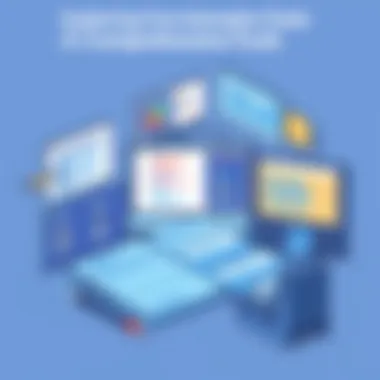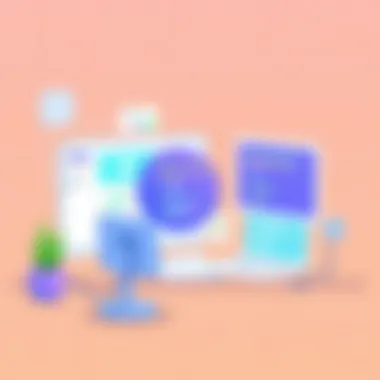Discovering No-Cost Animation Tools for Everyone


Intro
In the digital era, animation has become a powerful medium for storytelling and communication. Whether you're a budding animator or a seasoned pro, the ability to convey your message through animated visuals adds depth to your work. Fortunately, there are numerous free animation tools available that facilitate this creative process. This guide aims to shed light on these tools, their functionalities, and how they can enhance your projects without straining your wallet.
Key Features and Benefits
Understanding the key features and benefits of these tools is essential for making informed decisions.
Free animation tools come packed with various functionalities that cater to a wide range of users, from beginners to experts. Let's delve deeper into what these features entail.
Overview of Features
- User Interface - Most free animation platforms boast user-friendly interfaces, enabling novices to pick up the basics without a steep learning curve.
- Template Libraries - Many provide pre-built templates, easing the animation process. This is particularly helpful for users working on tight deadlines.
- Animation Styles - These tools vary in the animation styles they offer, including 2D, 3D, stop motion, and more, thereby catering to diverse creative visions.
- Export Options - Flexibility in export options, from GIFs to MP4 formats, ensures that users can share their work easily across different platforms.
- Collaboration Features - Some platforms offer collaborative tools, allowing multiple users to work on a project simultaneously, which is crucial for teams.
Benefits to Users
- Cost-Effective: Free tools eliminate barriers for those who may be unwilling or unable to invest in expensive software, making animation accessible to everyone.
- Learning Opportunities: These platforms serve as great learning tools for those looking to hone their skills without monetary commitments.
- Creative Flexibility: Users can explore various styles and techniques without the fear of wasting resources.
- Community Support: Many free platforms have strong user communities, providing forums for advice, feedback, and inspiration.
"The best way to learn is by doing. Free animation tools empower individuals to experiment and practice, fostering improvement and innovation."
Comparison with Alternatives
While free tools have their unique advantages, comparing them to paid alternatives can provide valuable insights into what they can and cannot achieve.
Head-to-Head Feature Analysis
When pitting free tools against their paid counterparts, the feature variations may be stark. Platforms like Blender offer extensive animation capabilities as a free 3D software option, but compared to premium software like Adobe After Effects, they may lack some advanced features and customer support.
Pricing Comparison
- Free Options: These are available without costs but may include limitations such as watermarks or fewer export formats.
- Paid Alternatives: Software like Toon Boom Harmony or Adobe Animate typically requires a subscription or a one-time purchase, providing in-depth features and support but at a price.
Preface
Animation is not just a shiny add-on for presentations or marketing; it has become a vital tool in storytelling, education, and branding. In today’s fast-paced digital arena, the ability to convey ideas through dynamic visuals has far-reaching implications. Individuals and businesses alike have recognized that animated content can captivate audiences far more effectively than static images or plain text. The integration of movement, color, and sound creates an immersive experience that facilitates better retention and engagement.
What makes animation particularly appealing is its accessibility. Free animation tools have democratized this medium, allowing anyone with a spark of creativity to turn their ideas into life. These platforms are a game changer, breaking down barriers that once made animation an exclusive domain of experts. This article aims to guide readers through a variety of free animation tools, addressing their unique features, usability, and overall effectiveness.
In this guide, we’ll explore how animation can enhance communication, spark interest in various subjects, and even provide a competitive advantage in business. By examining the options available, readers from various backgrounds, whether they are IT professionals, educators, or small business owners, can find the tools that suit their needs without breaking the bank.
"Animation is the illusion of life; it's about making everything we touch feel alive."
Through this exploration, we hope to demystify the animation process and encourage individuals to dive in and try their hand at creating. With so many resources at their fingertips, everyone can aspire to create impactful animated content. Let's break it down further.
Criteria for Choosing Animation Software
Selecting the right animation software is crucial, whether you're just starting out or you're a seasoned pro. The choice impacts everything from creativity to productivity. As the digital landscape evolves, having the right tools can turn an ordinary project into an incredible visual experience. When evaluating options, there are several key elements to consider, like user interface, functionality, and community support. Without a thorough understanding of these criteria, one might find themselves floundering in a sea of features without fully grasping which ones suit their needs best.
User Interface and Accessibility
When diving into animation software, the user interface (UI) is often the first layer users experience. A clean, intuitive UI is akin to a well-organized toolbox; it allows users to find what they need quickly. Consider a platform like OpenToonz. Its layout, designed with both novice and experienced users in mind, simplifies the animation process, making it less daunting for beginners. The trick is not to just focus on how it looks, but how it feels to work with.
Accessibility is another stitch in the fabric of good software. Think about this: animation shouldn't just be for the tech-savvy. Solutions should be available on various platforms, whether Windows or Mac, and even on mobile. A perfect example is FlipaClip, which not only offers a rich experience on tablets but also encourages creativity anytime, anywhere. In short, a welcoming UI paired with easy accessibility ensures that anyone can jump into animation without the fear of getting lost.


Functionality and Features
Once the UI has hooked you, the next step is to evaluate functionality and features. Every project is unique, so the software must possess a diverse range of capabilities. Take Blender, for example. It’s known for its extensive functionality, from 3D modeling to video editing, making it a one-stop-shop for many creators.
When sifting through features, focus on key necessities that match your objectives:
- Animation Techniques: Can the software handle both 2D and 3D animations? Does it support hand-drawn styles or vector graphics?
- Export Options: Find out how many formats, like MP4, GIF, or AVI are available to export your creations. This is essential for sharing them with the wider world.
- Templates and Resources: Some programs offer preloaded assets that can leapfrog you ahead in your project. A simple background or character animation can save time.
Tackling this before you settle on software can save headaches down the line.
Community and Support
Lastly, it’s worthwhile to consider the community and support surrounding any animation tool. A strong community is like having a group of friends who can lend a hand when you’re feeling stuck. It’s vital for sharing tips, tricks, and addressing common issues. Synfig Studio has cultivated a knowledgeable community where users discuss challenges and solutions, offering invaluable support.
Moreover, the availability of help documents and video tutorials can be invaluable. Some platforms even go a step further, offering forums or Discord channels where users can seek direct assistance.
Overview of Free Animation Tools
Animation has come a long way, making it accessible to everyone not just professionals who’ve got pockets deep enough to afford high-end software. Free animation tools are indispensable in today’s creative landscape. They provide an opportunity for budding artists and seasoned professionals alike to explore their craft without the financial burden. This overview serves to familiarize readers with available options, highlighting the benefits and considerations for each platform. Knowing which free tools meet specific needs is half the battle in thriving amidst numerous choices.
2D Animation Software
When delving into the realm of 2D animation, certain programs stand out. They offer distinct features that can cater to various size projects. 2D animation software tends to focus more on frame-by-frame animations, which can foster creativity and artistic expression.
OpenToonz
OpenToonz has established itself as a prominent contender in the world of open-source software. It’s well-regarded for its versatility and powerful features, making it a solid choice for animators working on both simple and more complex projects. The unique aspect of OpenToonz is its adaptability; users can modify its source code to fit their specific needs. However, some users may find the learning curve a bit steep at first—definitely not for the faint-hearted.
Synfig Studio
Synfig Studio shines when it comes to vector-based animations. One key characteristic that sets it apart is its capability to create complex animations without needing to produce them frame by frame. It offers free movement of characters and objects, allowing for fluid animations. That scalability makes it appealing without any financial constraints. On the downside, despite its rich features, some users report it can be sluggish when dealing with large projects.
Pencil2D
Pencil2D is the darling of many beginners. It simplifies the animation process, making it very approachable. The straightforward interface allows users to swap between raster and vector graphics with ease, which is a huge bonus. What really makes it remarkable is its focus on traditional hand-drawn animation, which can give a unique charm to projects. Nevertheless, seasoned animators might find it lacking some advanced features found in other high-end software.
3D Animation Software
Transitioning to 3D animation, multiple tools stand ready to assist artists in bringing their visions to life. Each platform has its own flair and capabilities that cater to different aspects of 3D design and animation.
Blender
Blender is a powerhouse in the world of 3D software. Known for its robust feature set, it covers everything from modeling to rigging and texturing. One of its key characteristics is its community support and extensive documentation, making it easier for users to solve issues on-the-go. The unique ability to create interactive 3D applications is an added incentive for many professionals. However, the depth of features can feel overwhelming for absolute beginners.
SketchUp Free
SketchUp Free is accessible and web-based, which means users can access the tool from almost anywhere. This makes it ideal for quick sketches and collaborative projects. Its core design is easy to grasp, allowing users to focus more on their creativity rather than learning complex tools. The trade-off comes in the form of limited functionality compared to its more advanced counterparts.
Clara.io
Clara.io offers a cloud-based platform, which means less dependency on hardware. One standout feature is its collaborative capabilities, allowing multiple users to work on a project simultaneously—great for teams. However, it does cater more to models than animations, so users who are solely focused on animating might find its offerings slightly lacking.


With this eclectic mix of software options in 2D and 3D categories, users can explore various styles and techniques without breaking the bank. Regardless of experience level, there’s a tool suited for each visionary. Ensuring the perfect fit for your animation projects enhances productivity and creativity, making for a more fulfilling creative process.
Web-Based Animation Platforms
In today’s digital age, the ability to create animation online has become more essential than ever. Web-based animation platforms offer an accessible way for both budding animators and seasoned professionals to design their work without the necessity for extensive software installations or high-end hardware. These platforms usually come with user-friendly interfaces and a wide variety of templates and assets.
Benefits of Web-Based Animation Platforms
- Accessibility: Users can access these tools from any device with internet connectivity. This flexibility allows for animation creation on-the-go, which is practical for professionals and enthusiasts alike.
- Variety of Tools: Most web-based platforms come equipped with a vast array of design options — from pre-made templates to custom asset creation. This variety caters to different animation styles, whether simple cartoons or more complex narratives.
- Collaboration Features: Many web-based platforms enable real-time collaboration, making them ideal for teams scattered across different locations. This feature allows multiple users to work on the same project simultaneously, fostering creativity and efficiency.
Considerations
While the perks are myriad, some limitations should not be overlooked:
- Internet Dependency: Accessing your work relies heavily on a stable internet connection; any disruption might hinder progress.
- Limited Features: Compared to downloadable software, web-based tools may offer fewer advanced features which can restrict complex animation tasks.
- Privacy Concerns: Storing projects online raises questions about data security. Users must be aware of the platform’s privacy settings and data policies.
Overall, web-based animation platforms have carved their niche by being incredibly user-friendly while opening doors for creativity. Now, let’s delve into some notable platforms in this space.
Animaker
Animaker provides an intuitive interface suitable for producing lively animations without requiring professional-level skills. The platform is equipped with an array of animated characters, background music, and a variety of templates that can expedite the design process. Users can easily drag and drop elements, making it accessible to individuals with limited animation experience. Notably, features such as character customization allow users to create animations that reflect personal or brand identities.
Canva Animation
Canva has taken the design world by storm, and its animation features are no exception. Beyond static graphics, it allows users to animate elements within designs effortlessly. While not as exhaustive in terms of animation options as dedicated tools, Canva’s simple animations—like entrance effects and movement transitions—are more than enough for those looking to spice up presentations and social media assets. Its vast library of images and elements assists in conceptualizing visually appealing content quickly.
Vyond
Vyond (formerly GoAnimate) is tailored for businesses aiming to create professional-grade animated videos. With a focus on storytelling, Vyond allows users to create character-driven narratives that engage audiences. The platform provides a library filled with scene templates and sound effects, simplifying the creation of informative videos for training or marketing purposes. However, its more advanced capabilities come with a price, as certain features are locked behind subscription plans.
Mobile Animation Applications
In today’s fast-paced digital world, mobile animation applications serve as a bridge between creativity and convenience. They empower users to produce animations at the tip of their fingers, making the art of storytelling accessible to a broader audience. With the rise of smartphones, animation isn't confined to desktops anymore; anyone with a mobile device can become an animator. These tools offer versatility, allowing creators to sketch, animate, and share their work seamlessly.
The benefits of mobile animation applications extend beyond just functionality. They cater to varying skill levels, from beginners dabbling in animation for fun to more seasoned creators looking for quick tools to animate ideas on the go. Plus, the ability to work from anywhere - whether in a café or on a train - adds a layer of flexibility that traditional software can’t match. Let's delve into two notable mobile applications that highlight this trend: FlipaClip and Toontastic.
FlipaClip
FlipaClip is a game-changer for aspiring animators. This application offers a simple interface that allows users to create frame-by-frame animations easily. It supports a range of creative styles, from traditional animation to contemporary digital art. Users can draw directly on their mobile screens, which makes animation feel like second nature.
- Key Features
- Layering: Much like animation software on desktop, FlipaClip allows for multiple layers, enhancing depth and complexity. This feature is ideal for adding backgrounds or adjusting character movements without losing previous work.
- Sound Integration: Users can add audio to their animations, making it a great tool for creating animated stories or presentations. This aspect opens creative doors for educational purposes as well.
- Shareability: With built-in options to share directly on social media platforms, creators can gain feedback and visibility for their work instantly.
The learning curve is fairly gentle, making it suitable for newcomers. While some might wish for more advanced features found in desktop applications, FlipaClip's strength lies in its accessibility and ease of use, providing a solid foundation for new animators.
Toontastic
Toontastic provides a unique approach to mobile animation, prioritizing storytelling and interactivity. Targeted primarily at younger audiences, it's an excellent tool for encouraging creativity in children while also being accessible for adults. This app allows users to create their own animated stories by guiding characters through various plots and settings.
- Interactive Storytelling: With character customization options, users can design their characters and control their narrative journey in real time. This makes animation engaging and personal.
- Guided Animation: The app includes prompts and ideas for stories, helping users who may feel overwhelmed when starting from scratch.
- Educational Benefits: For teachers and parents, Toontastic presents an engaging way to teach narrative structure and creativity. It appeals to the imaginative side of children, making learning fun.


Both FlipaClip and Toontastic illustrate the potency of mobile animation applications in the modern world. As they evolve, it's likely we'll see even more features that enhance creative expression and make animation a professional and hobbyist pursuit alike.
"Mobile animation tools are not merely applications; they represent a shift in how creativity can be harnessed in everyday life."
These applications reflect the potential for democratizing animation, allowing more people to participate in the digital storytelling movement, driving innovation and artistic exploration in ways once thought unattainable.
Considerations for Beginners
When starting out in the world of animation, the landscape can seem overwhelming. With a plethora of free tools at one's disposal, understanding how to navigate this space is critical. It is essential for beginners to grasp the considerations that come with choosing the right animation software and developing foundational skills. This section underscores the significantly practical aspects that shape your animation journey, aiming to create a smoother entry into the realm of animated storytelling.
Learning Curve
Animation isn't just about doodling figures on a screen; it encompasses a blend of artistry and technology. For beginners, the learning curve can feel steep. However, a well-chosen tool can ease that transition considerably.
- Understanding Basics: Each animation tool has its quirks. Familiarizing yourself with them lays the groundwork for more complex projects.
- Access to Tutorials: Many free platforms, like OpenToonz and Blender, provide substantial resources for new users to learn the ropes. It’s like having a mentor at your fingertips.
- Experimentation Is Key: Trying out different tools and styles allows creators to pinpoint what clicks for them. Explore, mess around, and don't be afraid to make mistakes.
This way, beginners can build confidence, gradually tackling more intricate animations as they go. It's not unusual to spend hours just playing around, but that's where real learning happens.
Essential Skills
While software capabilities vary, there are certain essential skills every aspiring animator should cultivate. Building these skills can lead to more compelling animations and enrich your creative toolbox.
- Storytelling: No animation stands alone without a good story. Developing a narrative not only engages the audience but also guides your animation flow.
- Timing and Spacing: Animation isn’t just about movement; it’s about how those movements are executed. Understanding the timing can infuse life into your creations.
- Drawing Skills: Even if you're using digital tools, basic drawing fundamentals can elevate your work. Knowing how to sketch even rudimentary shapes helps in framing the characters and scenes.
- Software Proficiency: Becoming comfortable with the tool you’ve chosen makes a world of difference. Regular practice, using the tutorials mentioned before, helps solidify your command.
- Feedback Utilization: Sharing your work with others, whether peers or online, opens the door to constructive criticism. Leverage feedback to refine your skills and approach.
By focusing on these skills, beginners can create a strong foundation for their animation endeavors. Taking the time to develop both artistic and technical abilities will pay off profoundly in the long run.
Advanced Tools for Professionals
When it comes to the realm of animation, not all tools are created equal. For serious animators and professionals, having access to advanced tools can be the difference between a good project and a great one. Production environments often demand precision, intricate details, and efficiency that free software can sometimes fail to provide. This section will delve into the main attributes that make certain animation software stand out for experienced users, focusing on open-source software that caters to demanding projects.
Open-source software such as Blender and OpenToonz allows for extensive customization and flexibility. This means that you can tailor your tools to fit specific needs, whether you’re working on a short animation or a comprehensive feature film. The beauty of these platforms lies also in their community-driven development. Interested users can contribute by providing plugins or features that suit niche requirements, a significant benefit for professionals who strive for innovations in their work.
The importance of powerful tools cannot be overstated:
- Integration with the Production Pipeline: Advanced tools seamlessly integrate with other software and systems used in the production process. This compatibility saves time during the transition phases, allowing for smoother workflows.
- Professional-grade Rendering Options: High-quality rendering is vital for producing animations that meet industry standards. Robust tools boast rendering technologies that can simulate complex lighting and physics-based environments, essential for creating visually captivating stories.
- Collaboration Features: Most professional projects involve teams. Tools that enhance collaboration by allowing for version control and easy asset sharing can significantly increase productivity across teams of animators, sound designers, and editors.
Moreover, maintaining an efficient workspace is crucial. Advanced tools often come equipped with features such as customizable shortcuts, user-defined workspaces, and scripting options that automate mundane tasks. This can lead to a considerable boost in productivity, giving professionals more time to focus on creativity rather than logistics.
Ultimately, the choice of animation software for professionals should not only align with project requirements but also assist in pushing the boundaries of creativity. Investing time in learning these advanced tools translates to better results and can help in impressing clients or audiences alike.
"Tools may shape the work, but it's the creative mind that animates the vision."
As we transition to discussing open-source software specifically designed for serious projects, we delve into options that not only meet high-quality standards but also encourage a spirit of community and collaboration.
The End
As we wrap up this exploration of free animation tools, it’s essential to underline the significance of understanding the evolving landscape of animation software. Whether you’re a seasoned animator or just dipping your toes into the vibrant world of animation, recognizing the strengths and limitations of the available tools is paramount for success.
The Future of Animation Software
The future of animation software is not just about advancements in technology; it’s also about accessibility and inclusivity. With many resources now available at zero cost, artists from all walks of life can bring their visions to life. Software like Blender and OpenToonz is setting the stage for a new era where creativity knows no bounds.
We’ve already witnessed significant shifts in industry standards and processes. The growing emphasis on open-source projects ensures that as technology improves, the tools used for animation will also become increasingly refined. Not to mention, robust communities are growing around these platforms, fostering collaboration and innovation.
The increasing integration of AI tools, like automatic character rigging and asset creation, is also reshaping what’s possible in animation. These features not only streamline the creative process but also allow animators to focus more on storytelling and less on the technical minutiae.
Furthermore, we cannot ignore the impact of collaborative cloud solutions. As remote work continues to rise, platforms that allow multiple users to work on projects simultaneously will become essential. This trend will help facilitate teamwork, particularly for small businesses aiming to create digital content without the overhead of expensive programs.
Investing your time in understanding these tools means you're not just preparing for today; you're arming yourself for the animation challenges of tomorrow.



